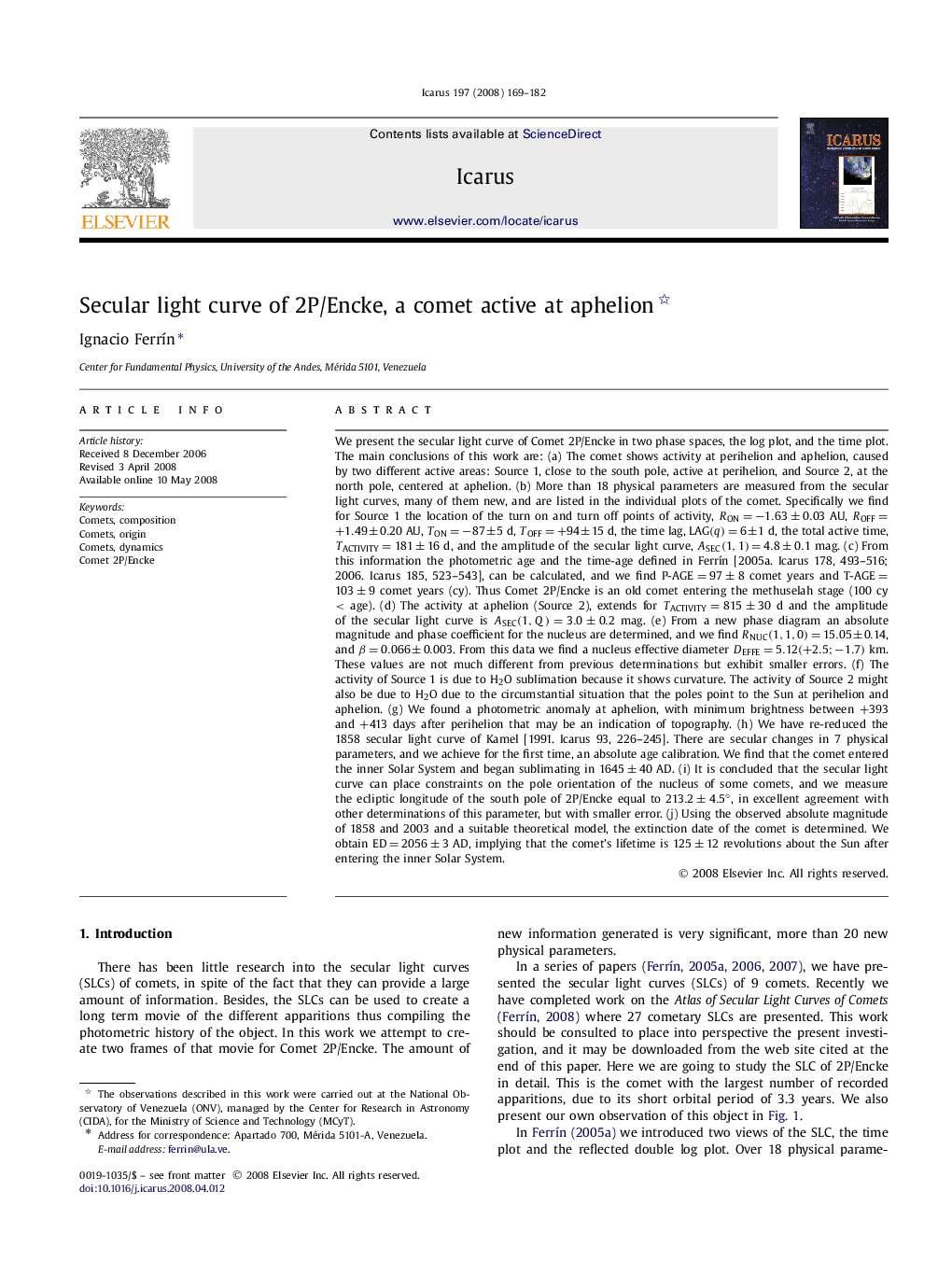| کد مقاله | کد نشریه | سال انتشار | مقاله انگلیسی | نسخه تمام متن |
|---|---|---|---|---|
| 1775006 | 1021181 | 2008 | 14 صفحه PDF | دانلود رایگان |

We present the secular light curve of Comet 2P/Encke in two phase spaces, the log plot, and the time plot. The main conclusions of this work are: (a) The comet shows activity at perihelion and aphelion, caused by two different active areas: Source 1, close to the south pole, active at perihelion, and Source 2, at the north pole, centered at aphelion. (b) More than 18 physical parameters are measured from the secular light curves, many of them new, and are listed in the individual plots of the comet. Specifically we find for Source 1 the location of the turn on and turn off points of activity, RON=−1.63±0.03 AURON=−1.63±0.03 AU, ROFF=+1.49±0.20 AUROFF=+1.49±0.20 AU, TON=−87±5 dTON=−87±5 d, TOFF=+94±15 dTOFF=+94±15 d, the time lag, LAG(q)=6±1 dLAG(q)=6±1 d, the total active time, TACTIVITY=181±16 dTACTIVITY=181±16 d, and the amplitude of the secular light curve, ASEC(1,1)=4.8±0.1 magASEC(1,1)=4.8±0.1 mag. (c) From this information the photometric age and the time-age defined in Ferrín [2005a. Icarus 178, 493–516; 2006. Icarus 185, 523–543], can be calculated, and we find P-AGE = 97 ± 8 comet years and T-AGE = 103 ± 9 comet years (cy). Thus Comet 2P/Encke is an old comet entering the methuselah stage (100 cy < age). (d) The activity at aphelion (Source 2), extends for TACTIVITY=815±30 dTACTIVITY=815±30 d and the amplitude of the secular light curve is ASEC(1,Q)=3.0±0.2 magASEC(1,Q)=3.0±0.2 mag. (e) From a new phase diagram an absolute magnitude and phase coefficient for the nucleus are determined, and we find RNUC(1,1,0)=15.05±0.14RNUC(1,1,0)=15.05±0.14, and β=0.066±0.003β=0.066±0.003. From this data we find a nucleus effective diameter DEFFE=5.12(+2.5;−1.7) kmDEFFE=5.12(+2.5;−1.7) km. These values are not much different from previous determinations but exhibit smaller errors. (f) The activity of Source 1 is due to H2O sublimation because it shows curvature. The activity of Source 2 might also be due to H2O due to the circumstantial situation that the poles point to the Sun at perihelion and aphelion. (g) We found a photometric anomaly at aphelion, with minimum brightness between +393 and +413 days after perihelion that may be an indication of topography. (h) We have re-reduced the 1858 secular light curve of Kamel [1991. Icarus 93, 226–245]. There are secular changes in 7 physical parameters, and we achieve for the first time, an absolute age calibration. We find that the comet entered the inner Solar System and began sublimating in 1645±40 AD1645±40 AD. (i) It is concluded that the secular light curve can place constraints on the pole orientation of the nucleus of some comets, and we measure the ecliptic longitude of the south pole of 2P/Encke equal to 213.2±4.5°213.2±4.5°, in excellent agreement with other determinations of this parameter, but with smaller error. (j) Using the observed absolute magnitude of 1858 and 2003 and a suitable theoretical model, the extinction date of the comet is determined. We obtain ED=2056±3 ADED=2056±3 AD, implying that the comet's lifetime is 125±12125±12 revolutions about the Sun after entering the inner Solar System.
Journal: Icarus - Volume 197, Issue 1, September 2008, Pages 169–182